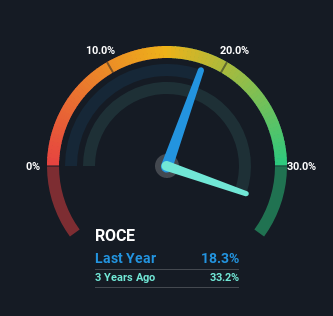- Hong Kong
- /
- Consumer Durables
- /
- SEHK:2381
Returns On Capital At SMC Electric (HKG:2381) Paint A Concerning Picture
If you're not sure where to start when looking for the next multi-bagger, there are a few key trends you should keep an eye out for. Typically, we'll want to notice a trend of growing return on capital employed (ROCE) and alongside that, an expanding base of capital employed. Put simply, these types of businesses are compounding machines, meaning they are continually reinvesting their earnings at ever-higher rates of return. However, after investigating SMC Electric (HKG:2381), we don't think it's current trends fit the mold of a multi-bagger.
What Is Return On Capital Employed (ROCE)?
If you haven't worked with ROCE before, it measures the 'return' (pre-tax profit) a company generates from capital employed in its business. Analysts use this formula to calculate it for SMC Electric:
Return on Capital Employed = Earnings Before Interest and Tax (EBIT) ÷ (Total Assets - Current Liabilities)
0.18 = HK$25m ÷ (HK$182m - HK$43m) (Based on the trailing twelve months to December 2022).
So, SMC Electric has an ROCE of 18%. On its own, that's a standard return, however it's much better than the 8.2% generated by the Consumer Durables industry.
See our latest analysis for SMC Electric

Historical performance is a great place to start when researching a stock so above you can see the gauge for SMC Electric's ROCE against it's prior returns. If you'd like to look at how SMC Electric has performed in the past in other metrics, you can view this free graph of past earnings, revenue and cash flow.
SWOT Analysis for SMC Electric
- Currently debt free.
- Dividend is in the top 25% of dividend payers in the market.
- Earnings declined over the past year.
- Trading below our estimate of fair value by more than 20%.
- Lack of analyst coverage makes it difficult to determine 2381's earnings prospects.
- Dividends are not covered by earnings.
How Are Returns Trending?
In terms of SMC Electric's historical ROCE movements, the trend isn't fantastic. To be more specific, ROCE has fallen from 40% over the last five years. However, given capital employed and revenue have both increased it appears that the business is currently pursuing growth, at the consequence of short term returns. And if the increased capital generates additional returns, the business, and thus shareholders, will benefit in the long run.
On a related note, SMC Electric has decreased its current liabilities to 24% of total assets. So we could link some of this to the decrease in ROCE. Effectively this means their suppliers or short-term creditors are funding less of the business, which reduces some elements of risk. Since the business is basically funding more of its operations with it's own money, you could argue this has made the business less efficient at generating ROCE.
The Key Takeaway
In summary, despite lower returns in the short term, we're encouraged to see that SMC Electric is reinvesting for growth and has higher sales as a result. These trends are starting to be recognized by investors since the stock has delivered a 9.4% gain to shareholders who've held over the last three years. Therefore we'd recommend looking further into this stock to confirm if it has the makings of a good investment.
Since virtually every company faces some risks, it's worth knowing what they are, and we've spotted 3 warning signs for SMC Electric (of which 1 is a bit concerning!) that you should know about.
While SMC Electric isn't earning the highest return, check out this free list of companies that are earning high returns on equity with solid balance sheets.
New: Manage All Your Stock Portfolios in One Place
We've created the ultimate portfolio companion for stock investors, and it's free.
• Connect an unlimited number of Portfolios and see your total in one currency
• Be alerted to new Warning Signs or Risks via email or mobile
• Track the Fair Value of your stocks
Have feedback on this article? Concerned about the content? Get in touch with us directly. Alternatively, email editorial-team (at) simplywallst.com.
This article by Simply Wall St is general in nature. We provide commentary based on historical data and analyst forecasts only using an unbiased methodology and our articles are not intended to be financial advice. It does not constitute a recommendation to buy or sell any stock, and does not take account of your objectives, or your financial situation. We aim to bring you long-term focused analysis driven by fundamental data. Note that our analysis may not factor in the latest price-sensitive company announcements or qualitative material. Simply Wall St has no position in any stocks mentioned.
About SEHK:2381
SMC Electric
An investment holding company, manufactures and sells electric tools and fans in the Americas, Asia, Oceania, Europe, and Africa.
Flawless balance sheet with proven track record.
Market Insights
Community Narratives



